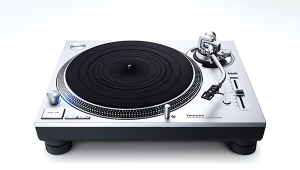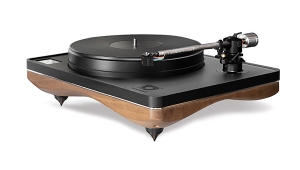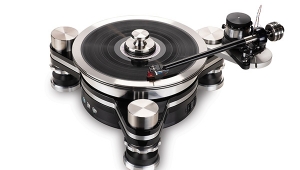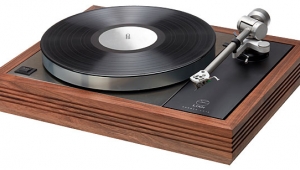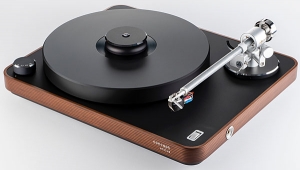| Columns Retired Columns & Blogs |
VPI HW-19 turntable
There is something refreshingly no-nonsense about the design and construction of this turntable. It looks as if someone just said, Okay, this, that, and the other thing need to be done. Let's do it. And then they did it. In appearance at least, it is about as simple a design as you're likely to find. What sets it apart from other simple designs is that this one is built like a battleship! Everything is heavy-duty (notto mention heavy), from the 10-lb, lead-laminated aluminum platter to the ¼"steel-reinforced subchassis.
Footnote 1: In my use of the 'table I found it necessary always to use a clamp or weight (such as VPI's own) to keep the record firmly against the smooth metal surface. The hardness of the platter's surface also made me very aware of the least bit of dust on the platter.—Larry Archibald
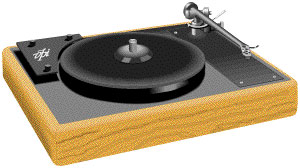 The platter is of solid aluminum, without the usual hollowed-out bottom, and a 1/8"-thick by 2"-wide band of lead is cemented to the platter's underside. Besides adding weight, the lead damps out ringing resonances in the aluminum, yielding an unusually inert platter. Tapping it with the finger produces only a satisfyingly brief "tick," without a vestige of ringing. No platter mat is supplied. The disc is supposed to go right onto the bare metal platter.
The platter is of solid aluminum, without the usual hollowed-out bottom, and a 1/8"-thick by 2"-wide band of lead is cemented to the platter's underside. Besides adding weight, the lead damps out ringing resonances in the aluminum, yielding an unusually inert platter. Tapping it with the finger produces only a satisfyingly brief "tick," without a vestige of ringing. No platter mat is supplied. The disc is supposed to go right onto the bare metal platter.
The subchassis is suspended on heavy springs at the corners, yielding a suspension resonance of around 5Hz. The springs are damped by the tried and true method of stuffing their insides with floppy foam plastic, which makes for a suspension that combines good vibration isolation with a high degree of stability. It jiggleth not! The panel is made of what appears to be ½" particle board, and screwed to the underside of this is a heavy steel sheet with folded edges for added rigidity. The whole suspended assembly weighs 24 lbs! The AC synchronous motor is attached to the base, not to the floating platform, and is coupled to the platter via a thin neoprene belt.
At the right side of the top panel is the arm-mounting board. This 5½"wide board fastens to the underlying steel plate via six heavy screws, spaced symmetrically so the board can be turned end for end. Thus, if you wish to install a different arm, requiring a different sized hole, you just rotate the board by 180° and you have a fresh corner through which to drill the new hole. As the 'table is supplied, there is only one large tonearm clearance hole in the supporting steel sheet, so only one arm can be mounted at any one time. If you wish to go to the trouble of cutting another large hole through the steel, I see no reason why two arms couldn't be permanently installed on the VPI.
This turntable has plenty of torque. Not as much as direct-drive 'tables, but enough to get it up to speed in a bit less than one revolution, and more than enough to use any of the record cleaning brushes on it without having it grind to a halt in mid-wipe. And, blessing upon blessing, the HW-19 is high enough so that tonearm cable dressing is no problem at all. There is no interference with the cable from any tonearm I've seen. In truth, though, this is of less importance with a heavy turntable than with lighter ones, because the heavier the suspension, the less it will respond to vibrations passed through the tonearm cable from the underlying tabletop. Still, it's nice to come across a high-quality 'table that I don't need to criticize for such a simple thing as height.
Ah yes, but how does it work? This is the best turntable I've had the pleasure of using to date. Perhaps I was psyching myself, but the solid appearance seemed to me to be reflected in the sound, which had a tautness and detail (particularly at the low end) which I have yet to hear equaled by any other turntable. The bare metal platter worked better than I had expected it to. I never had an instance of a disc rattling against it (footnote 1), and it seemed to do as good a job of absorbing vinyl resonances as the acrylic platter on the Pink Triangle, which has me a little baffled. Considering their vastly different densities, and thus (presumably) their differing ability to accept energy passed to them from the disc, it seemed to me that they should sound a lot more different than they did.
This judgment applies only to the VPI turntable we ended up with, many of whose parts were changed from the original. This aspect of product review is particularly frustrating. Here are the parts which were updated over the time of our having the turntable: the motor pulley; an added capacitor to the on-off switch; a new bearing-and-spindle assembly; a new and much heavier subchassis; and finally a new motor. The only unaffected parts were the platter, the tonearm board, the outer frame, and the switch. For those of you who may own older VPIs, I'll go through the changes wrought by each modification.
The original motor pulley had a square interior crosssection and tended to slip, particularly in warm weather or if the bearing was tight; the new pulley has a curved interior cross section and grips the belt (which has a corresponding round cross section) better. We changed the pulley ourselves, but don't recommend this for the general user. The procedure was difficult and may have damaged the motor.
Without the capacitor that was added across the on-off switch, a loud pop came through the loudspeakers when you turned the 'table on or off even when the turntable was on a separate house circuit. Adding the capacitor solved the problem, but if you have to be sure to use a 1µF cap; we used a 0.15µF cap and got continuous jiggling in the motor when it was off.
The new spindle is much more highly polished than the old one. It was difficult for us to evaluate the effect of just the polishing because our original spindle was binding and the turntable ended up running a little slow.
Recently we were sent a new subchassis with heavier steel reinforcement—this after I'd discovered (but had not yet reported to the manufacturer) a bit of audible drumminess from the fairly heavy original. While this last update was successful at accomplishing its purpose, I feel that more work needs to be done because of it. Specifically, some new way of adjusting the suspension should be devised. The old way consisted of turning the springs into and out of threaded sockets installed in the base. This could be accomplished from underneath the turntable, which is a pain in the you-know-what, but frequently it was neces sary to remove the subchassis. With the old subchassis this was difficult enough; with the new heavier subchassis (and no convenient handles), only finger-wrestling champions will succeed without damage to their digits. And the underneath-the-'table method no longer works: the new cork pads on top of the new springs don't slip beneath the subchassis. We've made a number of suggestions to Harry Weisfeld, the designer, but as yet there has been no further update to solve the problem.
And finally we replaced our original motor with one from another VPI 'table, to eliminate clearly audible rumble. In truth this is not an update, only a defective part. You can check your VPI turntable without having an LP with a silent groove: simply slip the belt off the motor pulley, turn on the motor, and put your ear to the subchassis. If you hear nothing, you're okay; on our original sample it was easy to hear the motor running. As mentioned above, the motor may have been damaged in the process of changing the pulley&3151;but then, we feel we shouln't have had to change the pulley!
As you might guess from the above, reviewing this turntable has been more like witnessing an ongoing birth then testing a finished product. Ordinarily ,this would turn us completely off, but the turntable VPi now sells really works well. When you look at the quality and rug gedness of the parts they use you can see that you're really getting an excellent value. We'd sure appreciate one more change, tliough: make the suspension easy to adjust. Once you've got the sus pension adjusted, this is a clearly recommendable product and a good deal.—J. Gordon Holt
Footnote 1: In my use of the 'table I found it necessary always to use a clamp or weight (such as VPI's own) to keep the record firmly against the smooth metal surface. The hardness of the platter's surface also made me very aware of the least bit of dust on the platter.—Larry Archibald
- Log in or register to post comments
